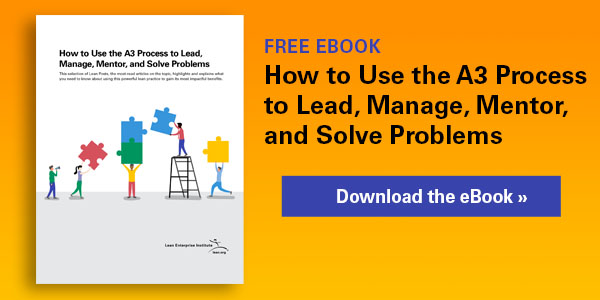After LEI published Managing to Learn: Using the A3 Management Process to Solve Problems, Gain Agreement, Manage, Mentor, and Lead, I reflected on the many conversations we had before deciding how to present the material. This reflection led me to recall my experience discovering the multifaceted nature of the process. I’m sharing my thoughts because I believe they will help you understand the many benefits of the A3 process.
Writing About the A3 Process
LEI had wanted to publish a book about the A3 process for several years before we finally published Managing to Learn. My dilemma during this time was that, while I was honored to be asked and could see the value of a book about the A3 process, I saw a significant challenge in writing it. The problem was: How would we convey how to use the A3 process as an effective — indeed, superior — way to manage people?
How would we convey how to use the A3 process as an effective — indeed, superior — way to manage people?
If we presented the A3 document as a tool and only showed how to write an A3 report, we would fail to demonstrate the broader and more significant aspects of the A3 process. And I especially didn’t want to write about the A3 process as if it were simply a report template to fill out. I have long viewed that using tools for tool’s sake (where everything is a hammer looking for a nail) is one of the most pernicious problems in “LeanWorld.”
So, working with the LEI editorial team, we quickly explored the idea of telling the story of how an individual prepared and used an A3 proposal. But even well-executed, that alone wouldn’t necessarily resolve my problem. I needed to tell the story from “both” sides since it takes two (at least) to gain the full benefits of the A3 management process.
I needed to tell the story from “both” sides since it takes two (at least) to gain the full benefits of the A3 management process.
After some discussion — and even rapid prototyping! — we landed on the equally radical but more practical (and innovative) idea of telling the story through two perspectives in running parallel columns. The two-column, side-by-side structure of the book was the most effective way to dynamically show the dual or multifaceted way of thinking embodied by the A3 process. First, it must generate learning for both the mentor and mentee. Second, it must simultaneously address a problem while exposing new ones.
My own experience many years ago revealed to me these and other dynamics of using A3 thinking.
Discovering the ‘A3’s’ True Value
Like all Toyota employees, I discovered firsthand the importance of the A3 process, In my case, my first managers, Isao Yoshino and Ken Kunieda, and coworkers desperately needed me to learn the thinking and skills that would make me useful! But, the process I went through was in no way special. When I joined Toyota in Toyota City (where, for a time, I was the only American) in late 1983, every newly hired college graduate employee began learning his job by being coached through the A3 process. The new employee would arrive at his new desk to find waiting for him a problem, a mentor, and a method to learn for solving that problem. The entire process was structured around the plan-do-check-act (PDCA) improvement cycle and captured in the A3 report.
The newcomer’s problem had been determined by his manager and scoped out by the mentor the manager assigned. The new employee would begin addressing the issue using this method. He would first seek to understand the situation by clarifying, analyzing, and investigating its causes. Then he would brainstorm and evaluate potential countermeasures. Finally, he would propose — that is, “sell” — his recommended countermeasure, which would often involve a simple trial or small experiment. Critically, in “selling” his proposal, he would strive to continually improve the content and accuracy of the A3 report by obtaining input and, as a result, agreement and support from others.
For example, my work team used the A3 process to solve a simple office problem, one common to anyone who has worked in an office and encountered the question, “Where’s the damned file?” The tools and practices the team used were unremarkable. What was remarkable was the effort and discipline the team put into such a mundane issue.
What is significant is how Toyota has systematized A3 thinking throughout the organization as a core management discipline.
While the solution improved our team’s ability to find the right information at the right time, the specific problem, the more significant benefit to our team was the training itself. By learning to apply the problem-solving tools in this situation, all the team members learned how to use them in others. Further, the training enhanced their thinking skills, which they could apply to every issue they would ever encounter. Practiced students of Total Quality Management (TQM) would quickly recognize the example as a very typical Quality Control (QC) Circle project report. What is significant is how Toyota has systematized A3 thinking throughout the organization as a core management discipline.
“Where’s the damned file?” was a simple problem, but the value of learning the process used to solve it extended far beyond its face value of enabling us to find files faster. That value is the education and learning embedded within a correctly executed A3 problem-solving process. As individuals or teams work through the A3 process, working on the improvement project, they learn problem-solving by doing. Indeed, the A3 process exemplifies learning through doing at its best.
The more A3s I wrote, the better I became at the A3 thought process. Internalizing that thinking is the objective, not technical mastery of
the format.
The more A3s I wrote, the better I became at the A3 thought process. Internalizing that thinking is the objective, not technical mastery of the format. The more cycles of reflection and learning that an individual can experience, the better it is for that individual and the organization.
Using the A3 ‘Tool’ for Problem-Solving
Still, the most fundamental use of the A3 process is as a simple problem-solving tool that you can use, applying the underlying principles and practices, in any organizational setting. So basically, the A3 process standardizes a methodology that helps people understand and respond to problems; it encourages root cause analysis, documents processes, and represents goals and action plans in a format that triggers conversation and learning. The A3 report, then, is a standardized way of summarizing problem-solving exercises.
A good A3 report has sound problem-solving — science — embedded inside. But it achieves much more, exemplifying this great quote by the great scientist Henri Poincaré: “Science is built of facts the way a house is built of bricks, but an accumulation of facts is no more science than a pile of bricks is a house.”
The A3 problem-solving process encourages root cause analysis, documents processes, and represents goals and action plans in a format that triggers conversation and learning.
In precisely the same way, a good A3 report is more than a collection of data that solves a problem — it tells a story that can coalesce an organization.
Editor’s Note: This Lean Post is an updated version of an article published on October 30, 2008, one of the most popular posts about this vital lean practice.
Managing to Learn with the A3 Process
Learn how to solve problems and develop problem solvers.








Hi again John! I wish two things. The first to be as a worker in Toyota. The second to be your trainee. I am studying A3 to understand more deeper it’s meaning. As I follow your great articles in this great website, I get more and more. I am retired and work as a management consultant in my city, Tehran. I am a member of the Association of Iranian Ex-Participants in JICA Training Courses. And participated in a training course, Productivity Improvement, that is held by AOTS in Yokohama City. The president of a production company asked me to help managers about A3 report. Now I am learning and helping them. Your articles are very useful for me. I understand that A3 Report is not only one page report. It is a way of thinking. There are at least 4 approaches under the table. Process approach, PDCA, Problem Solving and Long Term Philosophy. I am proud to be your virtual student, and eagerly follow your great articles. Thank you so much!
Very good – thank you John. I’m beginning to see the depth of something I was told many years ago regarding the intended outcome of any kaizen activity. The problem at hand should be addressed of course, but the development and growth of the team working on the problem should be improved as well.
I had not fully extended this idea to A3 thinking until now, so thanks!
Hi John! Thank you for opening my eyes to the second side of this coin. I did not think to the main philosophy of this apparently simple tool that it leads people to think, communicate and learn for solving the problems and developing organization. I shared it via linked-in. Good Luck!